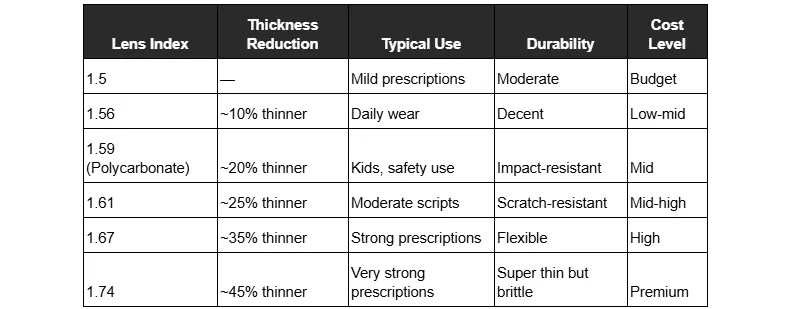- VOLUME 59: What’s the Best Lens Index for Prescription Glass Lenses?
VOLUME 59: What’s the Best Lens Index for Prescription Glass Lenses?
Monday, 4 August 2025Getting your script sorted is just the first step—choosing the best lens index can make a big difference to how your glasses fit, feel, and function. From eye strain and bulk to cost and aesthetics, getting it wrong can be a real pain. But make the right call and you’ll enjoy clearer vision, better comfort, and glasses that genuinely suit your lifestyle.
This guide will help you navigate your options without the waffle. You’ll get a solid understanding of what lens index means, why it’s important, and how to choose the right one based on your prescription strength, frames and daily habits.
Why does the lens index matter when choosing glasses?
Lens index impacts the thickness, weight and appearance of your lenses. It refers to how efficiently a lens bends light. The higher the index, the thinner the lens can be for the same level of correction.
- Thinner lenses put less pressure on your nose and ears, which matters when you’re wearing them all day.
- If your prescription is strong, a low-index lens can end up bulky and uncomfortable.
- A high-index lens looks neater, especially in rimless or semi-rimless frames where thickness shows more.
- They often come with extras like UV filtering, anti-glare and scratch resistance.
- That said, low-index lenses cost less and do the job fine for mild prescriptions.
Getting the right lens index is all about striking the balance between comfort, clarity, and appearance—without overspending.
Are high-index lenses always the better option?
Not always. High-index lenses suit many people but aren't a one-size-fits-all solution.
- If your script is mild—around ±1.00 to ±2.00—standard lenses are usually sweet.
- With stronger prescriptions, higher index lenses help keep things light and discreet.
- Without anti-reflective coatings, high-index lenses can reflect more light and reduce visibility.
- Some users reckon ultra-thin lenses feel fragile, even though they’re tough enough for everyday use.
- They’re a tidy choice for minimalist frames, but might not be worth it if your needs are basic.
In many cases, how well your frames work with different lens types is just as important as the index itself.
Can the wrong lens index affect your vision quality?
It can definitely affect both how you see and how your glasses feel over time.
- Using a low index for a strong script can leave you with chunky, heavy lenses.
- Heavier lenses might shift around or cause discomfort after a few hours.
- Thicker edges can sometimes mess with your peripheral vision, especially with bigger frames.
- High-index lenses may have a touch of chromatic aberration—those faint colour fringes—but most people don’t notice them.
- Choosing lenses with digital surfacing or tailored designs can help smooth these issues out.
When making your decision, it’s worth thinking about how to protect your vision, particularly if you have a complex prescription or spend long hours relying on your glasses.
How do prescription glass lenses vary by index type?
Each lens index offers its own mix of weight, thickness and durability. Here’s a quick comparison:
- Thinner doesn’t always mean stronger—some ultra-thin lenses are easier to chip or scratch.
- High-index lenses tend to give you crisper vision and better sun protection.
If you’re often outside, consider choosing the ideal tint and index for outdoor use to guard against harsh light and glare while keeping your lenses looking sharp.
Which lens index suits your prescription glass lenses best?
The right lens index depends on your prescription, frame style and how you use your glasses every day.
- Mild (±1.00 to ±2.00): A 1.50 or 1.56 lens should do just fine.
- Moderate (±2.25 to ±4.00): 1.59 or 1.61 strikes a good balance.
- Strong (±4.25 to ±6.00): Go for 1.67 to keep things tidy and lightweight.
- Very strong (above ±6.00): 1.74 is best for ultra-slim lenses and a clean look.
Some frames work better with thinner lenses. It pays to think ahead and select suitable lenses for your eye strength before choosing a frame, so your glasses fit properly and feel right from the start.
What should you ask before buying prescription glass lenses?
A little preparation goes a long way when choosing lenses. The right questions can save you from buyer’s remorse.
- Is this lens index suitable for my prescription and frame style?
- Are coatings like anti-scratch, UV protection or blue light filtering included?
- Will the lenses be too heavy for all-day wear?
- Should I go for polycarbonate for extra durability or active use?
- Does lens index affect returns, warranty or future upgrades?
These points might seem small, but they make a huge difference once you're wearing your glasses every day. A decent optometrist should explain your options clearly and help you weigh them up. Think about your routine, your frames, and your visual needs—good questions lead to better outcomes.
Final thoughts on choosing the right index for prescription glass lenses
Picking the right lens index isn’t just about saving money or slimming down your lenses—it’s about comfort, clarity, and confidence in your decision. If you’re still on the fence, you can always get expert help from Dresden Vision to find the lens index that fits both your lifestyle and prescription. A bit of clear advice can go a long way when your eyes are doing all the hard work.

